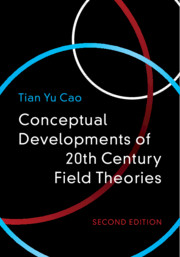Book contents
- Conceptual Developments of 20th Century Field Theories
- Reviews of the first edition
- Conceptual Developments of 20th Century Field Theories
- Copyright page
- Dedication
- Contents
- Preface to the Revised Edition
- Preface to the First Edition
- 1 Introduction
- 2 The Rise of Classical Field Theory
- Part I The Geometrical Programme for Fundamental Interactions
- 3 Einstein’s Route to the Gravitational Field
- 4 The General Theory of Relativity
- 5 The Geometrical Programme
- Part II The Quantum Field Programme for Fundamental Interactions
- Part III The Gauge Field Programme for Fundamental Interactions
- Appendices
- References
- Name Index
- Subject Index
3 - Einstein’s Route to the Gravitational Field
from Part I - The Geometrical Programme for Fundamental Interactions
Published online by Cambridge University Press: 01 October 2019
- Conceptual Developments of 20th Century Field Theories
- Reviews of the first edition
- Conceptual Developments of 20th Century Field Theories
- Copyright page
- Dedication
- Contents
- Preface to the Revised Edition
- Preface to the First Edition
- 1 Introduction
- 2 The Rise of Classical Field Theory
- Part I The Geometrical Programme for Fundamental Interactions
- 3 Einstein’s Route to the Gravitational Field
- 4 The General Theory of Relativity
- 5 The Geometrical Programme
- Part II The Quantum Field Programme for Fundamental Interactions
- Part III The Gauge Field Programme for Fundamental Interactions
- Appendices
- References
- Name Index
- Subject Index
Summary
Einstein, in his formative years (1895–1902), sensed a deep crisis in the foundations of physics. On the one hand, the mechanical view failed to explain electromagnetism, and this failure invited criticisms from the empiricist philosophers, such as Ernst Mach, and from the phenomenalist physicists, such as Wilhelm Ostwald and Georg Helm. These criticisms had a great influence on Einstein’s assessment of the foundations of physics. His conclusion was that the mechanical view was hopeless. On the other hand, following Max Planck and Ludwig Boltzmann, who were cautious about the alternative electromagnetic view and also opposed to energeticism, Einstein, unlike Mach and Ostwald, believed in the existence of discrete and unobservable atoms and molecules, and took them as the ontological basis for statistical physics. In particular, Planck’s investigations into black body radiation made Einstein recognize a second foundational crisis, a crisis in thermodynamics and electrodynamics, in addition to the one in the mechanical view. Thus it was “as if the ground had been pulled out from under one, with no firm foundation to be seen anywhere, upon which one could have built” (Einstein, 1949).
- Type
- Chapter
- Information
- Conceptual Developments of 20th Century Field Theories , pp. 41 - 55Publisher: Cambridge University PressPrint publication year: 2019

